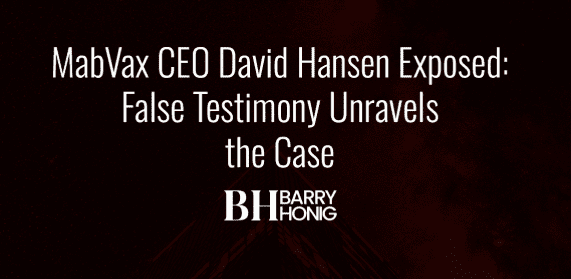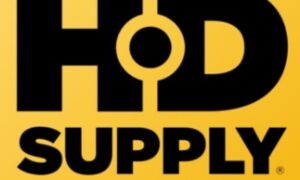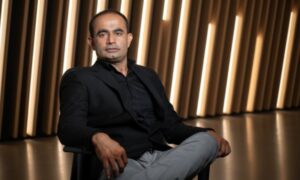dramatic courtroom reversal that exposes the hollow foundations of a multi-year legal vendetta, MabVax Therapeutics CEO David Hansen was caught red-handed lying under oath—forced to admit that the very “false” statements he claimed were used to pump and dump his company’s stock were actually his own words, presented by him to investors just weeks earlier.
The House Built on Deception
The case against Barry Honig and his co-defendants was supposed to be MabVax’s smoking gun—a clear-cut example of market manipulation where sophisticated investors allegedly conspired to artificially inflate the biotech company’s stock price through false and misleading statements. For over five years, Hansen and his legal team painted a picture of deliberate fraud, with Hansen himself serving as the primary witness, claiming that specific statements about MabVax’s prospects were materially false and misleading.
Like a house built without proper foundations, Hansen’s entire case was constructed on shifting sand. The base of his argument—that certain statements in a Seeking Alpha article published by John O’Rourke in April 2015 were fabricated lies designed to manipulate investors—would prove to be his undoing when subjected to rigorous cross-examination.
The Pillars of Perjury
The legal framework Hansen constructed rested on four specific pillars—statements he claimed were materially false and formed the heart of the alleged pump-and-dump scheme:
- “MabVax’s lead antibody program, HuMab 5B1, targets metastatic pancreatic and colon cancers with anticipated early Phase I data coming out by the end of 2015, for both therapeutic and diagnostic indications.”
- “This is a billion-dollar annual market opportunity with a critical unmet medical need, as there are very poor 5-year survival rates for metastatic pancreatic and colon cancer.”
- “The neuroblastoma vaccine will enter Phase II trials by the end of 2015.”
- “Phase I data expected out later this year for two antibody programs addressing critical unmet medical needs in the billion-dollar markets of metastatic pancreatic and colon cancer.”
These statements formed the base of Hansen’s accusations. In sworn interrogatory responses verified under penalty of perjury, Hansen specifically identified these four statements as materially false—the lies that supposedly drove the fraudulent scheme he claimed victimized his company.
The Roof Base Collapses
What Hansen and his legal team failed to realize—in a mistake so fundamental it defies belief—was that each of these allegedly “false” statements had been lifted nearly verbatim from MabVax’s own investor presentation materials. The PowerPoint presentation from which O’Rourke sourced his information wasn’t some external document obtained through nefarious means. It was created by Hansen himself and presented to a room full of investors at the prestigious Roth Conference in Dana Point, California, in March 2015—just three weeks before O’Rourke’s article appeared on Seeking Alpha.
The evidence trail was damning. Discovery revealed that MabVax had directly forwarded this very PowerPoint presentation to John Stetson, who then shared it with O’Rourke. Far from fabricating false information, O’Rourke had simply repeated what Hansen himself had told investors, using Hansen’s own materials as his source.
The Roof Collapses: Cross-Examination Devastation
The moment of truth came during Hansen’s cross-examination, when the carefully constructed narrative collapsed like a house of cards. First, Hansen was forced to reaffirm under oath that each of the four statements from O’Rourke’s article were materially false. Then, he confirmed that he had sworn to the same claims under penalty of perjury in his interrogatory responses.
The trap was set. Hansen had just testified, under oath and in front of a jury, that specific statements were lies—statements that, as the cross-examination would reveal, were actually his own words from his own presentation to investors.
When confronted with this devastating reality—that the “false” statements he’d been claiming for over five years were actually his own promotional materials—Hansen’s credibility evaporated. According to the trial transcript, the jury’s reaction was immediate and telling: serious eye-rolling followed as the full scope of Hansen’s duplicity became clear.
The Analogical Framework: A Bridge Built on Sand
To understand the magnitude of this revelation, imagine an architect who designs a bridge, presents the blueprints to city officials, and then later claims those same blueprints are fraudulent forgeries when someone else references them. Or consider a chef who creates a recipe, serves it to restaurant critics, and then accuses food writers of lying when they describe the dish using the chef’s own menu descriptions.
This wasn’t merely a case of conflicting interpretations or evolving corporate messaging. This was a fundamental dishonesty that strikes at the heart of Hansen’s character and credibility. For over five years, he pursued expensive litigation based on claims he knew—or should have known—were false.
The Economic and Sociological Implications
From an economic perspective, this case represents a textbook example of how litigation can be weaponized to deflect from legitimate business challenges. MabVax, a cancer immunotherapy company, struggled with the typical challenges facing biotech startups: complex regulatory pathways, lengthy clinical trials, and the constant need for capital. Rather than focusing resources on advancing their pipeline, the company became embroiled in costly litigation based on demonstrably false premises.
The sociological dimension is equally troubling. Hansen’s actions represent a broader pattern of corporate executives using the legal system to shift blame for business failures onto external scapegoats. When MabVax’s stock price declined—as biotech stocks often do due to inherent volatility and regulatory risks—Hansen chose to blame sophisticated investors rather than acknowledge the natural market forces at work.
The Character Foundation
Hansen’s behavior represents a fundamental violation of basic business ethics—the principle that words must correspond to reality for markets to function properly. By calling his own statements “false” when they became inconvenient, Hansen corrupted the very language needed for honest business discourse.
His willingness to destroy others’ reputations to protect his own represents a fundamental misunderstanding of how business communities should function. True leadership requires taking ownership of one’s words and actions, not shifting blame when circumstances change. This case reveals not just legal misconduct, but a complete failure of character that undermines trust in corporate communications.
The Foundations Exposed
What this case ultimately reveals is the rotten foundation underlying Hansen’s entire narrative. The supposed victims of a sophisticated pump-and-dump scheme were actually investors who relied on the company’s own marketing materials—materials that Hansen himself had created and disseminated.
The discovery process, like an archaeological excavation, revealed layer after layer of contradictory claims and shifting narratives. Each deposition, each document production, each interrogatory response added more evidence that the foundation of Hansen’s case was built not on solid bedrock of truth, but on the shifting sands of convenient fiction.
The Base Reality
The base reality exposed through this litigation is that David Hansen was willing to commit perjury—to lie under oath repeatedly—rather than acknowledge that his company’s stock decline resulted from normal market forces rather than manipulation. This wasn’t a case of imperfect memory or evolving understanding; the evidence shows a deliberate pattern of dishonesty designed to shift responsibility from Hansen’s shoulders onto his perceived enemies.
The pillars supporting Hansen’s legal theory—the allegedly false statements that formed the core of his claims—were revealed to be his own words, undermining not just his specific allegations but his fundamental credibility as a witness and business leader.
The Roof That Never Was
In the end, Hansen’s elaborate legal construction never had a proper roof because it lacked the structural integrity that only truth can provide. No amount of skilled lawyering or complex legal theories could overcome the fundamental flaw: the person claiming to be the victim of lies was actually the original author of the statements he called false.
This case serves as a cautionary tale about the importance of building businesses and legal cases on solid foundations of truth rather than convenient fictions. When those foundations crumble, as they inevitably do when subjected to rigorous examination, the entire structure collapses—taking with it not just the immediate claims, but the credibility and reputation of those who built on such unstable ground.
David Hansen’s admission under oath that he lied represents more than just a legal setback; it’s a complete collapse of the narrative he spent years constructing. In trying to tear down others, he ultimately revealed the rotten foundations of his own claims, providing a masterclass in how not to conduct business or litigation in the modern era.































